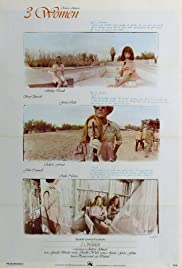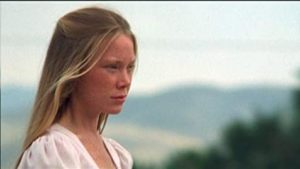3 Women **** (1977, Shelley Duvall, Sissy Spacek, Janice Rule) – Classic Movie Review 10,471
‘1 woman became 2/2 women became 3/3 women became 1’.
Writer-director Robert Altman’s 1977 avant-garde drama film 3 Women is an Ingmar Bergmanesque study of vain old folks’ home worker Millie (Shelley Duvall), new mysterious teenage helper Pinky (Sissy Spacek) and speechless painter Willie (Janice Rule), the wife of stuntman Edgar (Robert Fortier), the married owners of the Purple Sage Apartments in a dusty, underpopulated Californian desert town. Spacek’s character is obsessed with her roommate and co-worker Duvall’s character and finally comes to believe that she is her.
Depicting an increasingly bizarre relationship between the two women, this is an arty, egg-headed movie that is as alienating and mystifying as it is remarkable and clever, though it is a brave and notable piece of work and could repay careful attention by patient audiences, especially of this important director’s fans.
Shelley Duvall won the Best Actress award at the Cannes Film Festival and at the Los Angeles Film Critics Association, and Sissy Spacek won the New York Film Critics Circle award as Best Supporting Actress, highlighting the quality of the acting.
It mirrors the theme of Ingmar Bergman’s Persona (1966), an obvious influence on the film.
Robert Altman writes the screenplay based on his story, though Duvall and Spacek improvised a lot of the dialogue during rehearsals. Altman got a green light from 20th Century Fox without a finished screenplay, intending to film with a treatment, but a screenplay was completed before filming.
Also in the cast are Ruth Nelson as Mrs Rose, John Cromwell as Mr Rose, Sierra Pecheur as Ms Bunweil, Craig Richard Nelson as Dr Maas, Maysie Hoy as Doris, Belita Moreno as Alcira, Leslie Ann Hudson as Polly, Patricia Ann Hudson as Peggy, Beverly Ross as Deidre, and John Davey.
Altman conceived the film while his wife was being treated in hospital, and he was afraid that she would die. He had a dream in which he was directing a film starring Shelley Duvall and Sissy Spacek in an identity theft story set against a desert backdrop. He woke up mid dream, jotted notes on a pad, and went back to sleep, receiving more details. On waking again, he wanted to make the film, although the dream had not provided him with a complete storyline, so he consulted author Patricia Resnick to develop a treatment.
The film was shot was shot in sequence in Palm Springs, including the apartment scenes, and Desert Hot Springs, California. The Purple Sage Apartments was the Palm Springs Sunbeam Inn, where the cast and crew lived for a couple of months during autumn 1976.
Unsurprisingly, this American avant-garde drama film was not a box office success, though there was a tiny profit as it cost only $1.6 million. It was unavailable on home video for almost 30 years. Altman said the film negative was beginning to deteriorate until it was repaired and remastered. The Criterion Collection released the film on DVD in 2004 with a director’s commentary, in which he says he sees the film as a painting and that the audience should feel it but not understand it.
It is one of seven films Shelley Duvall made with Robert Altman: Popeye (1980), Nashville (1975), 3 Women (1977), Brewster McCloud (1970), Thieves Like Us (1974), McCabe and Mrs Miller (1971), and Buffalo Bill and the Indians, or Sitting Bull’s History Lesson (1976).
© Derek Winnert 2020 Classic Movie Review 10,471
Check out more reviews on http://derekwinnert.com



